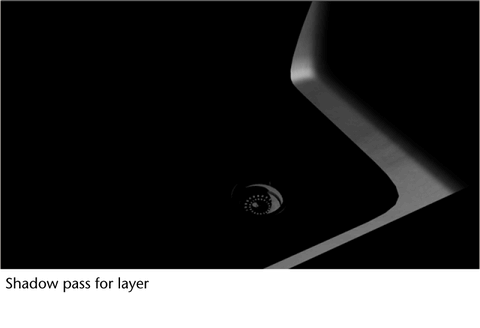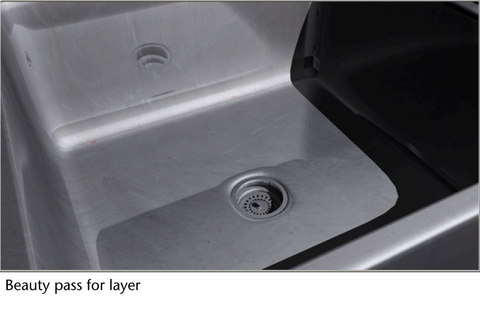In this scene there is a render layer, named
KitchenSink, which includes a sink and a spotlight. The sink has
a Phong shader applied to it
and the spotlight’s Use Ray Trace Shadows attribute
is enabled. Use the following simple workflow to obtain a diffuse,
reflection, shadow and specular pass for this layer.
NoteThe multi-render
pass feature is supported for the mental ray renderer. The rendering
API allows other 3rd party renderers and custom renderers to support
it moving forward.
Create render passes for
the render layer
- With the KitchenSink layer selected,
open the Render Settings window and
select mental ray as your renderer.
- Select the Passes tab
and click the New Pass
 button
to create a new render pass. The Create Render Passes window
appears.
button
to create a new render pass. The Create Render Passes window
appears.
- Select the following render passes. You
can multi-select items: Diffuse Without Shadows, Reflection, Shadow,
and Specular Without Shadows. Click
the Create and Close button. Four
render passes named diffuseNoShadow, reflection, shadow, specularNoShadow
are created and appear under the Scene Passes section
NoteBy default, a beauty
pass is also created for the each layer once the selected passes
have been created.
- Use the arrow buttons to move the passes
to the Associated Passes section. This
makes the passes available to the current layer.
- Render the scene. By default, if you
render from the scene view, your rendered images are saved to the
subdirectory <RenderLayer>\<camera>\<RenderPass> under
the images\tmp directory
of your project file. Maya also creates a MasterBeauty folder where
it saves the default beauty pass for the scene. The image file name <scene>.iff is used for each
rendered image. If you batch render, the rendered images are saved
directly to the images directory.
NoteIf you render using
the Render View window, you can
also preview your render pass output by selecting File
> Load Render Pass.
Beyond this example
In addition to creating
render passes for the entire render layer, you can also create render
passes for a subset of the objects and lights in your render layer. You
can do this by creating a render pass contribution map. See
Creating render pass contribution maps for
more information.
You can also customize
the subfolders and filenames to which the rendered images are stored.
See
Creating subfolders and filenames for rendered images for
more information.
If you have many render
passes in your scene, you can group them into render pass sets,
for example, an Illumination pass set that includes
all passes involving lights, such as diffuse, and ambient. See
Using render pass sets in your scene for
more information.







